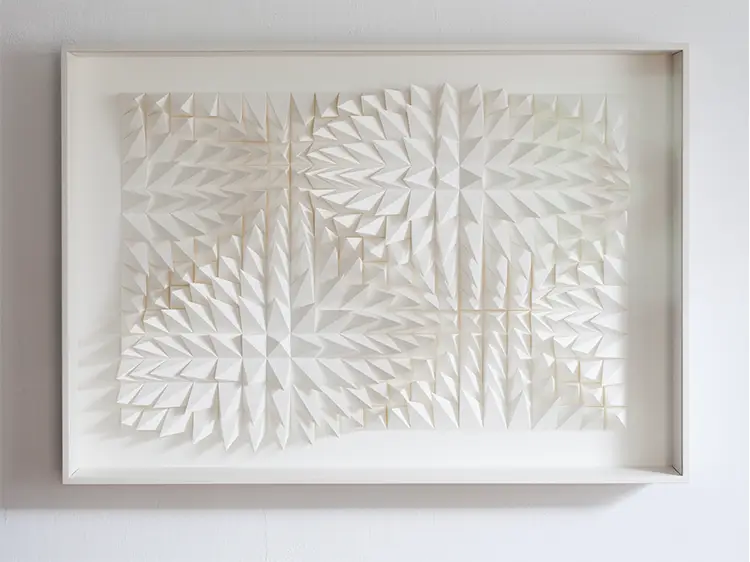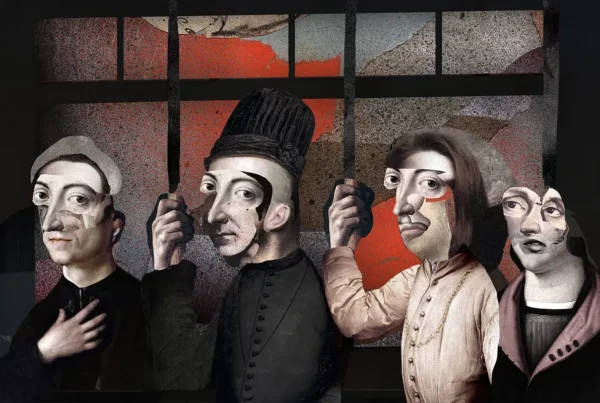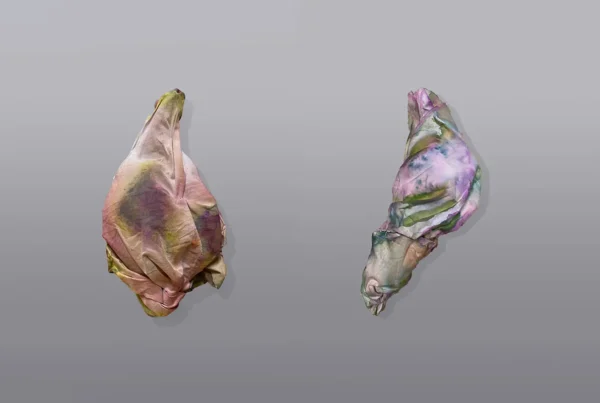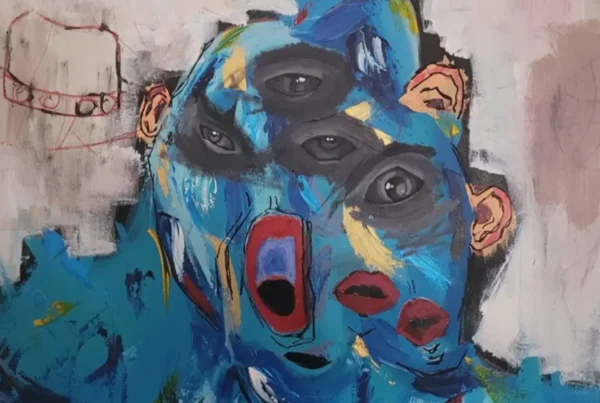“My art career began as a search for a more personal and creatively liberating outlet alongside my architecture work, and it gradually evolved into my full-time occupation.”
Reimagining Space Through Form and Light
Anna Kruhelska stands at the intersection of architecture and contemporary art, transforming structural knowledge into tactile, visual poetry. Based in Łódź, Poland, her journey from architectural design to the creation of intricate wall reliefs demonstrates a shift from blueprint logic to the freedom of artistic exploration. With over 17 years of experience as an architect and having contributed to ambitious projects in Russia, Malaysia, and the UK, Kruhelska brings a sophisticated spatial awareness to her art. Her work is characterized by a crisp aesthetic, rooted in clean lines and a fascination with balance—qualities unmistakably shaped by her architectural past.
Her creative identity found new life in 2018, when she began channeling her passion for minimalism and structure into a more intimate practice. Paper became her chosen material—familiar from her university days but now rediscovered as a medium for personal expression. Initially conceived as a side project to counterbalance the rigid constraints of architectural regulations, her art practice steadily grew into a full-time endeavor. The transition was born out of a desire to escape the collaborative, often compromise-laden world of building design, and to embrace a solo journey defined by tactile engagement, instinct, and self-directed vision.
This evolution has allowed Kruhelska to investigate visual themes from a new angle, guided less by functional requirements and more by aesthetics and emotion. Her wall reliefs, whether made from paper or plywood, do more than decorate space—they alter it. The attention she gives to form, light, and movement makes each piece an exercise in balance and quiet dynamism. They evoke a sense of calm, offering viewers a visual rhythm that plays with perspective, shadow, and the illusion of motion.
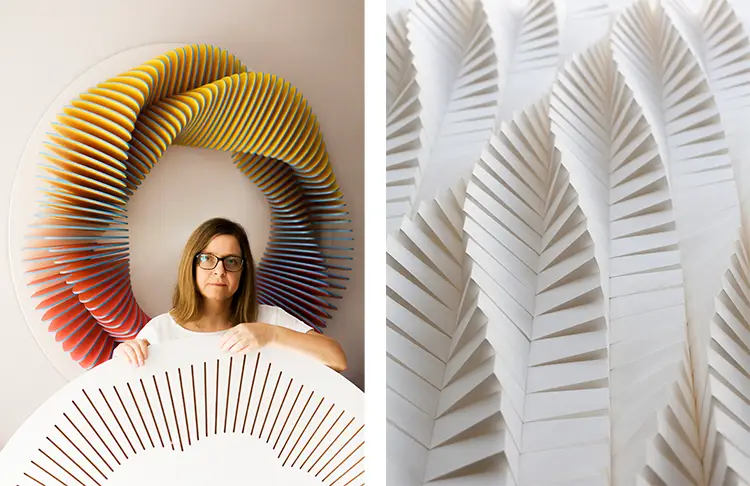
Anna Kruhelska: Geometry in Motion
Kruhelska’s distinctive visual language is shaped by her fascination with minimalism and abstraction, where clarity of form takes precedence over figurative representation. Her artistic output spans two primary mediums—paper and plywood—each chosen for its ability to respond to geometry and manipulation. Paper, with its pliable yet structural quality when folded, allows her to create rhythmic surface compositions that shift with the light. In contrast, plywood lends itself to larger, more colorful explorations, as seen in her acclaimed series such as Constant Change and Color Maze.
At the heart of her work is a deep exploration of visual opposites—movement and stillness, flatness and depth, repetition and variation. Her paper reliefs emphasize tonal gradients created by light as it interacts with folded surfaces, creating a meditative flow that draws the viewer into a quiet experience. These early works hold particular significance for Kruhelska, as they mark the foundational steps of her artistic evolution. Transitioning from vast architectural projects to intimate, handcrafted pieces was not just a technical shift but a philosophical one—one that reaffirmed the value of patience, repetition, and solitary creation.
In her plywood compositions, Kruhelska shifts gears slightly, allowing color and curvature to take center stage. Here, the idea of movement becomes more explicit, with interlocking shapes and fluid gradients that suggest transitions and transformation. These works speak to the continuous processes of change and growth, themes that resonate both personally and universally. Despite the difference in materials and visual tone, her plywood and paper works share a common foundation in precision and the calculated beauty of form, consistently reflecting her architectural roots.
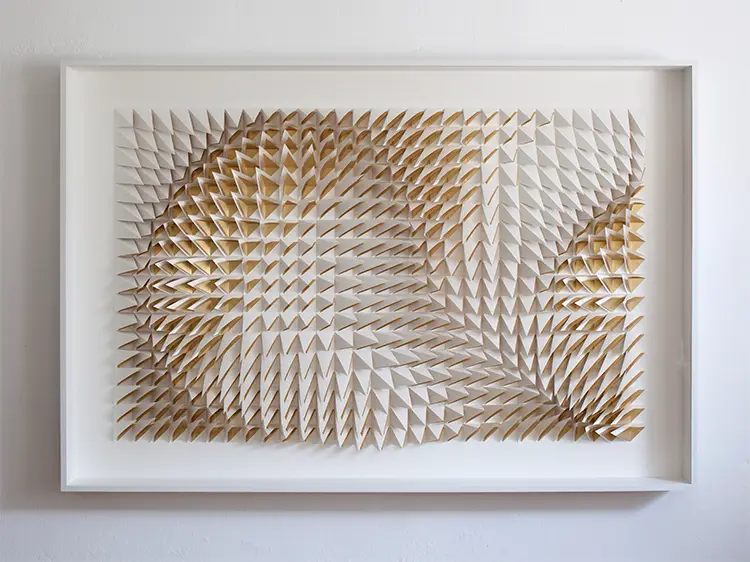
Crafting Through Code and Contemplation
Kruhelska’s creative process is a hybrid of digital strategy and tactile execution. Each project begins on the computer, where she employs 3D modeling and algorithmic coding to establish the design’s formal parameters. This initial stage is critical—it gives her control over how shapes evolve, interact, and fit within a defined space. However, her practice is not confined to the digital realm. After the blueprint is set, she transitions into the physical making process, which includes cutting, folding, assembling, and painting by hand. This dual approach allows her to balance the precision of computation with the intimacy of handcraft.
The making itself becomes a meditative act, particularly during the repetitive tasks that require close attention and consistency. For Kruhelska, this phase is not just about execution; it’s a form of deep focus that fosters calm and clarity. Her studio must accommodate both these facets—digital design and physical assembly—so she can shift seamlessly between planning and building. This integrated environment supports a workflow that is simultaneously structured and instinctual, demanding both analytical and emotional investment.
Distractions, though inevitable, are often absorbed by the rhythm of her manual work. The concentration required to fold hundreds of precise creases or to align multiple layers becomes a form of escape. It is in this state of quiet repetition that ideas deepen and evolve. Her artistic choices, from geometric structures to fluid compositions, are often born in the silence of these moments—where the digital logic of design meets the slow rhythm of the hand.
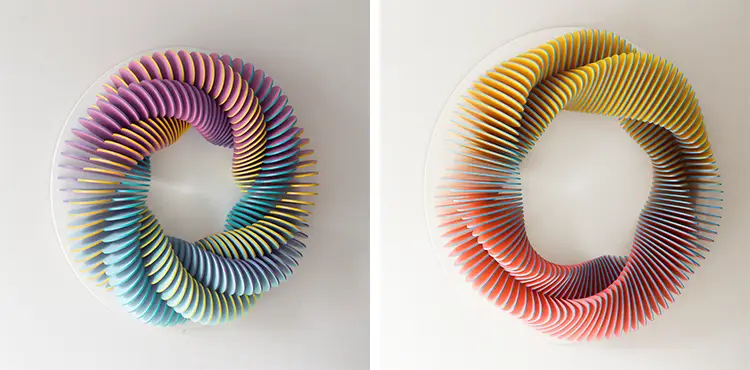
Anna Kruhelska: A City, A Wall, A Dream Taking Shape
Among the projects dearest to Kruhelska’s heart is a recent commission that brings her art into the public domain—a large-scale 3D wall installation planned for her hometown of Łódź. This opportunity marks a significant milestone, blending her dual passions for art and architecture into a work that will engage the broader community. Having proposed several potential locations in consultation with the city council and urban planners, she now stands at the threshold of transforming her vision into a lasting fixture within the cityscape.
The significance of this project goes beyond its physical scale. It reflects her ongoing desire to blur the lines between private contemplation and public interaction. The installation will allow her to scale her intricate wall relief concepts into a format that can be experienced on a civic level, engaging with both architecture and viewers in motion. This is not merely a display but an invitation for passersby to witness how surface, form, and light can reframe even the most familiar urban spaces.
Although the project is still in its early planning stages, it represents a full-circle moment for Kruhelska. It unites her background in large-scale construction with her current focus on art as a personal and sensory experience. The upcoming installation stands as a testament to how an artist can carry the essence of her practice—symmetry, structure, and subtlety—into the wider world, leaving a mark not only on walls, but on the way people experience their environment.
